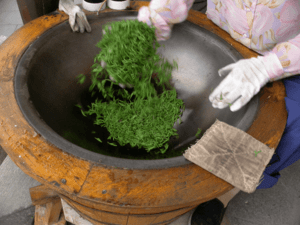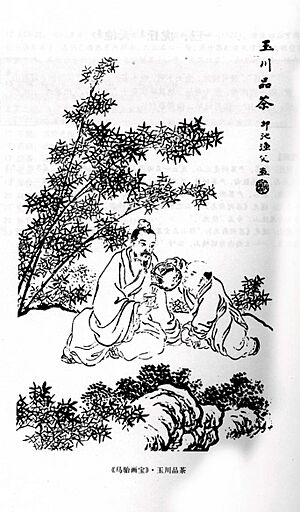History of tea in China facts for kids
The history of tea in China is super old and interesting! Chinese people have loved tea for thousands of years. Long ago, smart people thought tea could cure sicknesses. Rich people showed off their status by drinking fancy tea. And everyday people just enjoyed its great taste.
In 2016, scientists found the oldest proof of tea. It was in the tomb of Emperor Jing of Han (who died in 141 BCE) in Xi'an. This showed that emperors from the Han dynasty drank tea made from the Camellia plant as early as the 2nd century BCE. Tea then became very popular during the Tang (618–907 CE) and Song (960–1279 CE) Dynasties.
Contents
How Tea Was Discovered: A Legend
According to an old story, tea was first found by a legendary Chinese emperor named Shennong. He was also a famous herbalist, someone who studies plants for medicine. This happened way back in 2737 BCE.
Emperor Shennong liked his drinking water boiled to make it clean. So, his servants always boiled it for him. One day, while traveling, he and his army stopped to rest. A servant was boiling water, and a dead leaf from a wild tea bush fell into the pot.
The water turned a brownish color. No one noticed, and it was given to the emperor anyway. The emperor drank it and found it very refreshing! That's how "cha" (tea) was supposedly discovered.
The Erya, an old Chinese dictionary from the 3rd century BCE, mentions a drink made from leaves. This was used as early as the Zhou Dynasty (1046–256 BCE).
Tea's Early Uses in China
It's not totally clear when tea was first used as a medicine to help people stay awake. But China has the oldest records of tea drinking. People were using tea in the first millennium BCE.
During the Han dynasty (206 BCE–220 CE), tea was mainly used as medicine. Drinking tea just for fun, during social events, became popular later. This happened around the Tang Dynasty (618–907 CE) or even earlier.
Lu Yu and The Classic of Tea
A famous book called The Classic of Tea (《茶經》) was written by Lu Yu. He was a writer from the Tang dynasty (729-804 CE). This book is one of the earliest works about tea.
According to Lu Yu's book, tea drinking was very common around 760 CE. The book explains how tea plants were grown. It also describes how the leaves were prepared and how tea was made into a drink. Lu Yu's book even talked about how to judge the quality of tea and where the best tea leaves grew.
How Tea Was Prepared Long Ago
Back then, tea was made and prepared very differently from how we drink it today. Tea leaves were pressed into hard, flat cakes. These dried tea cakes were often called brick tea.
People would grind the brick tea into a powder using a stone grinder. Then, they would add hot water to the powder. Sometimes, the powdered tea was boiled in clay pots. This hot drink was then ready to be enjoyed. The Japanese matcha tea, which is powdered green tea, comes from these older Chinese traditions.
A type of pressed tea, similar to what we now call white tea, was made during the Tang Dynasty (618–907 CE). This special Tang white tea was picked in early spring. At that time, the tea bushes had many new growths that looked like silver needles. These "first flushes" were used to make the pressed tea.
Tea is a very important part of Chinese culture. It's even mentioned as one of the Seven necessities of (Chinese) daily life. Tea was also used in China to help people relax.
Making Tea: Roasting and Brewing
For many centuries, steaming tea leaves was the main way to prepare tea. After people stopped using compressed tea cakes, the way tea was made for selling and sharing changed again. The Chinese learned a new way to process tea in the mid-13th century.
How Tea Leaves Are Processed
After tea leaves are picked, they go through a process often called "fermentation." This isn't exactly like the fermentation that makes yogurt or bread. Instead, it's a natural chemical change where substances in the tea leaves react with air. This process changes the color and flavor of the tea.
When the tea leaves dry, this process stops. This allows tea makers to control how much the tea changes. They can also stop it by heating the leaves, for example, by steaming or pan-frying them. This heating method is known as "shāqīng" (殺青).
In the 17th century, many improvements were made in tea processing. In southern China, tea leaves were dried in the sun and then partly processed. This created Oolong tea, also known as "black dragon tea." However, this method wasn't common everywhere in China.
Tea was also used as medicine, and people often added salt to it to make it taste less bitter.
Tea in Chinese Stories
- Lu Yu wrote in his book, The Classic of Tea, that "Tea as a beverage started with Shennong."
- An old medicine book called Shennong Ben Cao Jing said that "Shennong tasted hundreds of herbs. He met seventy-two poisons daily and used tea as an antidote" (a medicine to stop poison).
- In Chinese legends, Shennong is said to have died in Tea Hill (Chaling County), Hunan.
Where Tea Plants Grew in China
- In 760 CE, Lu Yu already wrote that tea was a "grand tree from the South." He said they could be very tall, from one to several dozen "Chi" (an old Chinese measurement). Some trees were even two meters (6.6 feet) around!
- A. Wilson, while exploring southeast China, found tea bushes up to ten feet tall in the mountains of Sichuan.
- In 1939, plant scientists found a wild tea tree that was 7.5 meters (24.6 feet) tall in Guizhou province.
- In 1940, another wild tea tree, 6.6 meters (21.7 feet) tall, was found on Old Eagle mountain in Guizhou.
- In 1957, a 12-meter (39.4 feet) wild tea tree was found in Cheshui county of Guizhou.
- In 1961, an amazing discovery was made in the rainforest of Yunnan. A wild tea tree was found that was 1,700 years old! It was thirty-two meters (105 feet) tall and more than one meter (3.3 feet) wide. This is known as the "king of tea trees."
- More wild tea trees, many over ten meters tall, were found in the mountains of Sichuan, Yunnan, and Guizhou provinces.
The Names of Tea Over Time
- In ancient Chinese writings like the Shi Jing (The Book of Songs), tea was called 'tu' (荼).
- In another old Chinese book, Er Ya, from the early Han Dynasty, tea was called 'jia' (檟). It said, "Jia is bitter tu." A scholar named Guo Pu (276–324 CE) later explained that "Tu is a small plant, its leaves can be brewed into a beverage."
- Tea was also called "She" (蔎) in a West Han book about dialects.
- During the Han dynasty, the word 'tu' started to be pronounced 'cha' as well as 'tu'.
The sound 'tu' (荼) later became 'te' in the Fujian dialect of Chinese. This is where the English word 'tea' and 'te' in other languages come from.
The sound 'she' (蔎) later became 'soh' in Jiangsu province.
The sound 'jia' (檟) later became 'cha' and 'chai' (used in Russia and India).
During the Sui dynasty and Tang Dynasty, drinking tea became very common. From China, tea then spread west to Tibet.
The first time the word 'cha' was used instead of 'tu' for tea was in Lu Yu's book, The Classic of Tea, around 760 CE.
Important Times in Tea History
- From ancient times until the Spring and Autumn period (221 BCE), tea was used in special ceremonies as an offering.
- Chinese history records show that around 1000 BCE, there were already tea farms in Sichuan and Yunnan.
- From the end of the Spring and Autumn period to the early Western Han dynasty, tea was eaten as a vegetable.
- An old text mentions that a prime minister (547 BCE–490 BCE) had egg and tea as food on his table.
- Another text says that since the Jin dynasty, people in Wu (now Suzhou city) cooked tea leaves as food and called it "tea broth."
- From the beginning to the middle of the Western Han dynasty, tea was used as medicine.
- From the late Western Han Dynasty to the Three Kingdoms Period, tea became a special drink for emperors.
- From the Western Jin dynasty to the Sui dynasty, tea became a popular drink for everyone in China.
- From the Tang period onwards, tea became one of the seven most important things in daily life.
- During the Southern Song Dynasty, a Japanese monk named Eisai came to China to study Buddhism (1168 CE). When he went back home in 1193 CE, he brought tea from China to Japan. He planted it and wrote the first Japanese book about tea. This was the start of tea growing and tea culture in Japan.
- In the Song Dynasty, tea was a major export good (something sold to other countries). Through the Silk Road on land and sea, tea spread to Arab countries and Africa.
- Some historians think Marco Polo saw tea during his travels. But other historians say his writings don't mention tea at all.
Making White Tea for Everyone
Modern white teas can be traced back to the Qing Dynasty in 1796. Back then, teas were processed and sold as loose leaves that you would steep (soak in hot water). They were made from a mixed type of tea bush. These white teas were different from other Chinese green teas because they weren't steamed or pan-fired. The leaves were also shaped. The early "Silver Needle" white teas were thin, small, and didn't have much silvery-white fuzz.
It wasn't until 1885 that specific types of tea bushes were chosen to make "Silver Needles" and other white teas. The large, soft buds of "Big White," "Small White," and "Narcissus" tea bushes were picked to make white teas. These are still used today to make white tea. By 1891, the large, silvery-white "Silver Needle" tea was being sold to other countries. The making of "White Peony" tea started around 1922.
The First Book About Tea
The first book specifically about tea, Cha Jing by Tang dynasty writer Lu Yu, was finished around 760 CE. This was more than four hundred years before the first Japanese tea book by Eisai. There are no known ancient Indian books about tea.
There were about one hundred books about tea written from the Tang dynasty to the Qing dynasty. This amazing collection of tea culture is just starting to get attention from scholars in the West.
See also
 In Spanish: Cultura china del té para niños
In Spanish: Cultura china del té para niños



